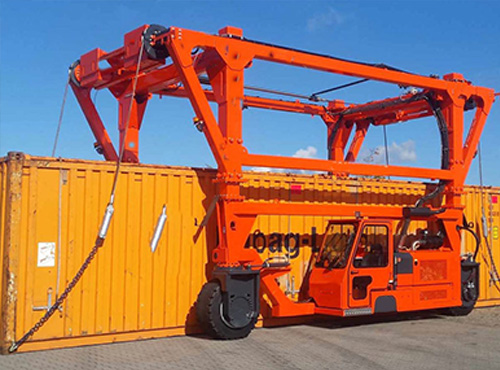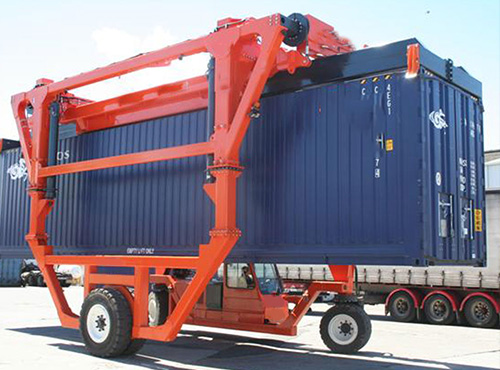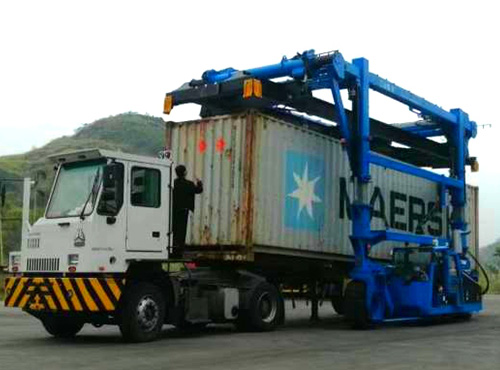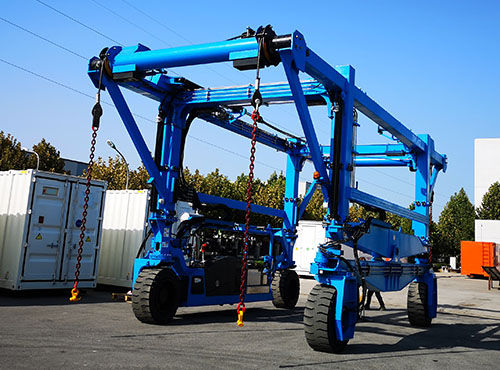A shipping container straddle carrier is a specialized vehicle designed for the efficient movement and transportation of shipping containers within a container terminal or storage yard. The shipping container straddle carrier’s design enables it to navigate easily between rows of stacked containers, allowing for efficient loading, unloading, and repositioning. Its lifting capacity typically ranges from 30 to 60 tons, to make it suitable for handling standard-sized and high-cube containers commonly used in maritime shipping.
The distinctive feature of huadelift shipping container straddle carrier is its ability to straddle the containers, gripping them from above, and lift them off the ground for transportation. The shipping container straddle carrier’s mobility is enhanced by its rubber tires, which provide flexibility in maneuvering around the terminal.
A shipping container straddle carrier consists of several key components, each playing a vital role in its efficient and reliable operation. Here are the main parts of a shipping container straddle carrier:


Chassis
The chassis forms the base of the shipping container straddle carrier and provides structural support for the entire machine. It is designed to withstand heavy loads and dynamic stresses during container handling.
Cabin or Operator’s Cab
The operator’s cab is where the straddle carrier is controlled. It is equipped with a console, joystick controls, and a display panel that allows the operator to manage the movement, lifting, and positioning of containers.
Lifting Mechanism
The lifting mechanism consists of horizontal arms equipped with spreader beams. These arms can be adjusted to shipping container straddle containers and lift them off the ground. The lifting capacity varies depending on the specific model of the shipping container straddle carrier.
Spreader or Twistlocks
The spreader or twistlocks are the components attached to the lifting mechanism that physically engage with the corners of the shipping containers. They secure the container during lifting and transportation.
Tires
Straddle carriers are equipped with large rubber tires that provide mobility and allow them to move easily on the terminal’s surfaces. The tires contribute to the flexibility of the straddle carrier in navigating between stacks of containers.
Hydraulic System
The hydraulic system powers the lifting mechanism and other moving parts of the shipping container straddle carrier. It enables smooth and precise control over the positioning of containers.
Engine
The engine, often located within the chassis, provides the necessary power to drive the container straddle carrier. It is usually a diesel engine, chosen for its combination of power and fuel efficiency.
Control System
The control system encompasses the electronics and software that manage the various functions of the shipping container straddle carrier. It includes safety features, diagnostics, and interfaces for the operator to control the machine effectively.
Shipping container straddle carriers and rubber tired gantry cranes (RTGs) are both types of specialized equipment used in container terminals, but they differ in their design, functionality, and operational characteristics.
1.Design and Mobility
Shipping container straddle carrier
Shipping container straddle carriers have a wheeled chassis with large rubber tires. They straddle the containers, using a lifting mechanism to hoist and transport them. The tires allow for easy mobility and flexibility in navigating between stacks of containers.
RTG: rubber tired gantry crane RTGs, on the other hand, have a gantry structure with legs fitted with rubber tires. They move along fixed rails or tracks, running perpendicular to the rows of containers. RTGs lift containers with a spreader that is mounted on a trolley that travels horizontally along the gantry structure.
2.Lifting and Stacking
Shipping container straddle carrier: Straddle carriers lift containers from the top using horizontal arms equipped with spreader beams. They are capable of stacking containers one over the other in a more flexible manner due to their ability to straddle and reach containers from various positions.
RTG: RTGs lift containers from the top as well, they typically stack containers in a straight line along the rows, and their stacking height is limited by the height of the gantry structure.
3.Infrastructure Requirements
Shipping container straddle carrier: Straddle carriers do not require fixed infrastructure like rails, making them suitable for terminals without an extensive rail network. They operate on paved surfaces.
RTG: RTGs operate on a rail system, requiring the installation of rails throughout the container yard. This fixed infrastructure provides stability but may limit flexibility in layout changes.


1.Clear Your Requirements
2.Capacity and Size
3.Stacking Height
4.Operational Speed and Efficiency
5.Maintenance and Support
6.Safety Features
7.Cost Considerations
If you are looking for a suitable shipping container straddle carrier, you can contact us. Huadelift will help you choose a suitable shipping container straddle carrier.